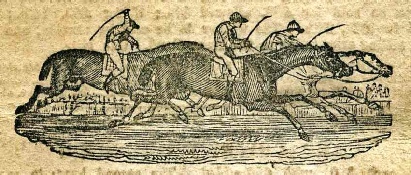


|
The Griffins of Stockton Fields (later Hill Farm) 1817- |

|
It was November 1834, William IV was on the throne, and in the previous month the Palace of Westminster had burned down and Birmingham Town Hall was opened. Among other newspapers, the Leamington Spa Courier of the 22nd, and the Coventry Herald and Observer of the 21st, reported on a steeple chase, or chace, held on Wednesday 19th over a distance of “about four miles”, from “Ladbrook Hill” (“Plumber’s Hill” in the Courier), to “Mr Griffin’s house in Stockton fields”. At the 1841 census, one Joseph Plummer was a farmer in an area of Ladbroke described by the census enumerator as “The Fields”; the more detailed 1851 census gives his address as “Ladbrook Hill”. Ladbroke Hill Farm is shown on the modern Ordnance Survey map at the top of the hill, at a height of 138 metres (450 feet). In a straight line, the distance from Ladbroke Hill is three miles one furlong (exactly five kilometres). By all accounts, the five runners and riders enjoyed good weather for their 15-
The report in the Coventry Herald and Observer is much the briefer of the two, and written in a much less literary style. It gives this description of the course: "The country was generally flat and good, terminating in a slight ascent, and the fences were not very large, excepting a few towards the end of the chace. The run was however intersected by two brooks, but taking the ground altogether, it was good." One of these "brooks" would have been the River Stowe, which flows through Southam. To this day, locals call it "the brook". The Courier reporter writes of "brooks of very doubtful nature, forming a very predominant feature in the contest". One of the contemporary meanings of doubtful was fearful, though the riders must surely have known, or at least known of, the best places to cross with least risk. The following is a transcription of the report in the Courier. The prize was worth £3,500 in today's money. From THE LEAMINGTON SPA COURIER And Warwick Borough and County Gazette Saturday, November 22, 1834 STEEPLE CHASE, NEAR LEAMINGTON. A steeple race, four miles across country, for a silver cup, value £35, seven subscribers at £5 each to carry 11st. 7lb., came off Wednesday last. The spot selected was in every way calculated to try the strength of the horses and the skill of the riders, and has been declared by several sporting characters to be the finest line of ground for the purpose in the midland counties. A considerable number of persons assembled at Southam, in the neighbourhood of which town it was understood the affair would take place. The jockeys met at the New Inn, and the usual preliminaries gone through, when it was announced that two of the subscribers, whose names did not transpire, had not paid the amount of their subscriptions. This gave rise to much wrangling and unpleasantness, and the greater number of spectators assembled were dreading the probability of a "no- Affairs now assuming a more pleasing aspect, the parties proceeded to the place of starting, being a field two miles on the London road, called Plumber's Hill; the winning post being a house occupied by Mr. Griffin, farmer, of Stockton. The assemblage of sporting characters, and of some of our fairest belles, on horseback, together with the pedestrians from Leamington, Warwick, and a distance of from 12 to 15 miles, was now very great; and during the race several splendid equipages continued to arrive. To the pleasure afforded by the appearance of a morning favourable for the sport, was added the circumstance of the horses having proved themselves good ones on former occasions, and upon the whole a dashing race was confidently anticipated. The following were the horses that started :— Mr. Gomm's b. g. Single Peeper (rode by Denwick) - Mr. Sirdefield's ch. g. The Duke (owner) Mr. Ind's b. g. Cantab (owner) Mr. Bryan's ch. g. The Butcher (Bamford) The start took place at half- |
| 2 Sitemap |
| 3 Maps |
| Late Victorian map of Stockton |
| Pre 1844 O.S. map Stockton-Long Itchington |
| Stockton Fields - 2 |
| Stockton Fields - 3 |
| Stockton Fields - 4 |
